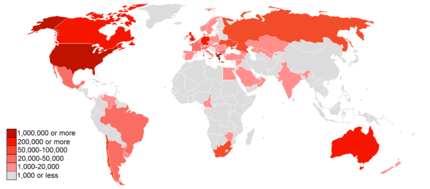Greek Mexicans
| Total population | |
|---|---|
|
248 Greece-born residents (2015)[1] est.1,500 families of Greek descent[2] | |
| Regions with significant populations | |
| Sinaloa, Mexico City, Guadalajara | |
| Languages | |
| Mexican Spanish and Greek | |
| Religion | |
| Christianity | |
| Related ethnic groups | |
| Greeks and Greek diaspora |
Greek Mexicans (Greek: Ελληνομεξικανοί) are Mexican residents of either full or partial Greek descent. The largest Greek communities are in Mexico City, Guadalajara, and Sinaloa. Smaller numbers of Greeks can be found in Aguascalientes, Acaponeta, Tepic, and Pachuca.
History

Greeks have immigrated to Mexico since the 18th century, with the largest influx arriving in the mid-20th century and settling in Mexico City, Sinaloa state, and border cities. While many had left Greece due to war and political instability in Greece, the Mexican government also offered incentives for Greeks to work in Mexico, specifically in Sinaloa. During the 1940s, the Mexican government invited a large number of Greeks to Sinaloa to improve harvest of tomatoes.[3] Soon the Greek community became so large that the area around the Tamazula, Humaya, and Culiacán rivers became known as the "Valle de Grecia" (“Valley of Greece”).[4] Today, Sinaloa has a heavy Greek presence, and Greek surnames are very common in the state. Greek Mexican families can also be found in other major cities around the republic, such as Mexico City and Guadalajara.
Figures
Statistics regarding exact number of Greek people in Mexico vary greatly, especially due to the different numbers for native-born Greeks and for Mexicans of Greek descent. The only official number is of native-born Greeks, which stood at 298 at the time the Mexican national census of 2000.[5] When including descendants of Greeks, published estimates range from 1,000 to 4,000 individuals.
The General Secretariat for Greeks Abroad estimates that only 1,000 Greeks live in Mexico.[6] On the other hand, according to the Greek Ministry of Foreign Affairs, the number stands at about 4,000, including descendants of Greeks.[7] In agreement with the estimate by the Greek Ministry of Foreign Affairs, Elena Stamatiadou, president of the Comunidad Helenica de Mexico in Mexico City, estimated that there were at least 1,500 Greek families living in Mexico. Stamatiadou stated that most families were made up of second and third-generation Greeks from Euboea, Greece's second largest island.[8] A lower estimate of 300 families was published in Greece Now magazine in 2004.[9] Other sources report significant numbers of immigrants from Cyprus and mainland Greece.
Communities
Sinaloa
The state of Sinaloa arguably has the largest Greek community in all of Mexico, with estimates in the capital city of Culiacán alone standing at 2,000 individuals.[7] Greeks can also be found in the cities of Mazatlán, Guamúchil, Guasave, and Los Mochis. Culiacán is home to the Comunidad Helénica of Culiacán (Hellenic Community of Culiacán).[10]
Mexico City

Around 250 Greek Mexican families, or 1,500 individuals, live in and around Mexico City.[7] A major centerpiece of the Greek community of the Greater Mexico City area is the Greek Orthodox Church of Santa Sofia in Naucalpan, Mexico State.[11] The church also serves as the home for the Comunidad Helenica de Mexico, or Hellenic Community of Mexico.
Guadalajara
Guadalajara is home to around 230 Greeks.[7] It is also the home of the Casa Helenica de Guadalajara (Hellenic House of Guadalajara) and the Amigos de Grecia (Friends of Greece), which organize community events and offers Greek classes to the public. Elsewhere in the state of Jalisco, the municipality of Colotlán also boasts its own Greek community.[8]
Numbers
Notable people Homero Aridjis, prominent writer
See alsoReferences
External links
| |||||||||||||||||||||||||||||||||||
